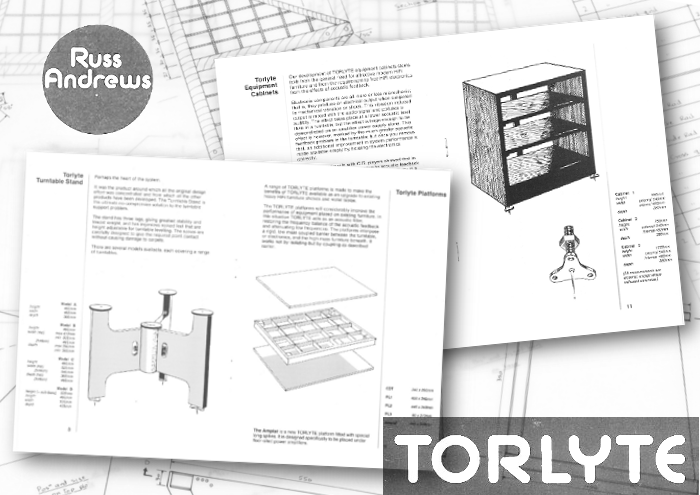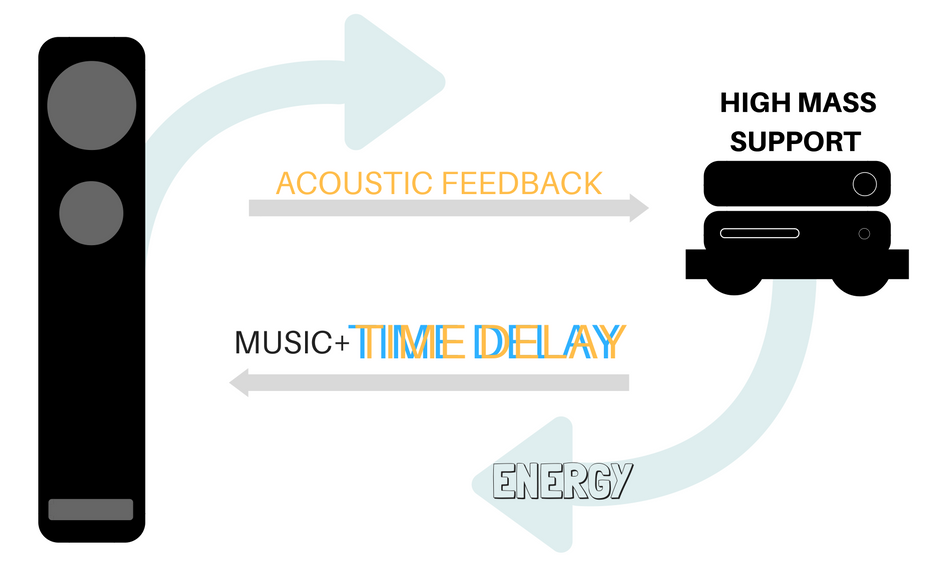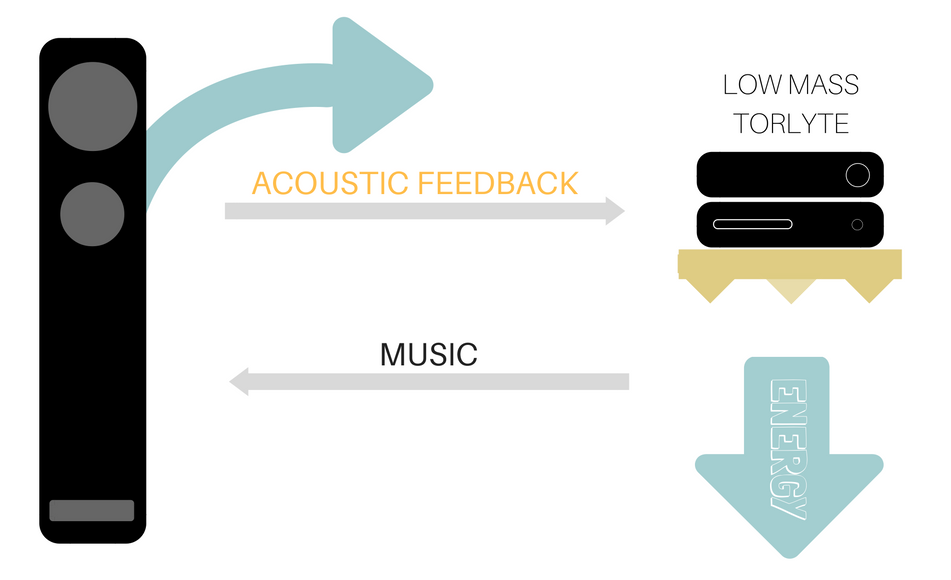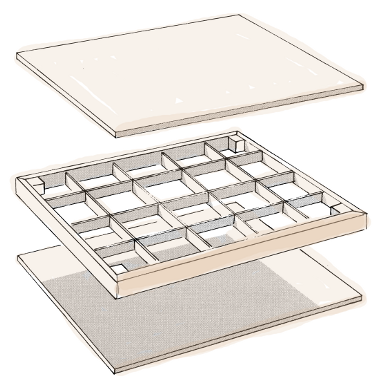
For many years we were intrigued by the fact that a Hi-Fi system can sound radically different in different locations. In researching this, we came to reject the conventional answer - that it was just due to room acoustics - and began to notice that there were several, hitherto unnoticed variables at work.
We discovered that the furniture on which the system stood made a significant contribution to the sound. Several years of analysis and development have led to what we consider to be an ideal solution to the problem: TORLYTE.
Our Torlyte range is the only range of Hi-Fi furniture that addresses both the technical and aesthetic aspect of living with Hi-Fi equipment.
Torlyte designs combine the qualities of originality and functional beauty with rigorous technical analysis to create a range that enhance both the appearance and, more importantly the performance of the Hi-Fi system and the room in which is it installed. This is quite unique - no other furniture fulfils both these requirements.
The Development of Torlyte
Dealing with Acoustic Feedback Energy
Acoustic feedback energy from your loudspeakers is the problem, so we must somehow 'deal' with that energy to stop it causing trouble. Unfortunately, we can't just destroy it because as Sir Isaac Newton so elegantly proved:
'Energy can be neither created or destroyed'
He also proved that:
'In every action there is an equal and opposite reaction'
We can't stop the energy getting into the system, but the energy itself isn't really the problem, it's the effect that energy has - time delay - that is the real problem.
The time delays occur because the feedback energy is slowed down and stored as it passes through and into each part of the system. It is the mass (weight) of each object that dictates how much energy is stored. The higher the mass of an object, the lower its 'resonant frequency'. (Every object has its own 'natural resonant frequency'; the frequency it vibrates at when you knock it.) The lower the frequency then the more energy is stored and the more the energy is slowed down. This slowing down means that the object will continue to vibrate (or resonate) for longer thereby adding to time smear.

If high mass increases time delay, then low mass will decrease time delay. The lighter (lower mass) things are, the less energy they can store, the less they can ring, and the less they can delay the feedback energy.
Therefore, if we could make the system support materials very light we would have a system that stores little energy and delays it less. We will have raised the speed of reaction to the feedback energy and as a result reduced the time smear. We know we can't stop energy moving but if we ensure that it moves as fast as possible through the system, and that all parts of the system vibrate together and very fast, then the vibrating ceases to matter. To do this we must couple all the light weight parts of the system together in such a way that we allow the energy to pass freely from one to another, without coupling their masses together to create one big high (slow) mass.

Coupling the masses is a technique used by cinematographers filming microscopic single cell marine organisms. The camera has a motor that vibrates it so much that the organisms in the water tank would be invisible. The solution? They clamp the water tank to the camera so that it all vibrates together and so the vibration itself doesn't matter.
CLICK HERE TO BUY NOW
The influence of materials
There is, however, another problem caused by the feedback energy. The tonal character of the music (frequency response) is changed by the materials the feedback travels through. In other words, you can 'hear' the support materials in the feedback signal and it changes the sound of the music. You can hear the metallic ringing of metal stands, the 'dong' and ring of glass shelves, the thick heavy thump of medite (MDF), etc. Proponents of the conventional high mass support system go one step further, to make problems even worse. They say that the equipment should be 'isolated' from the shelves with soft 'squidgy' rubber feet. This has the unfortunate effect of trapping the feedback energy in the piece of equipment, thereby increasing the storage and delay!
A further and equally music destroying effect of all this weight and stored energy is to reduce the dynamic range of the music. It concentrates all the energy in a narrower band, delivering a sound that is louder, punchier and more up-front. Mid-bass is forward and dominant, and the treble grabs you by the throat!
On certain kinds of Rock music this sound effect is much favoured in Hi-Fi circles at the moment, but other kinds of music reveal it for the sound effect it really is. Unfortunately, it is the sound most people associate with a Hi-Fi system these days and that is a tragedy for enthusiasts and for the industry. Don't let this sound fool you - stand back and hear it for what it really is, the way ordinary non-enthusiasts hear it.
Your friends and neighbours should be stunned by the totally believable, natural sound your system makes, not laughing at you for wasting so much money on a loud obnoxious row! Believe me, though, once you change your approach and your system starts to deliver clean, clear, relaxed, natural music, the attitudes of family and friends will change dramatically. They will congratulate you on what you have done to the system, will enjoy listening to it, and will approve further upgrades. Your friends will visit more often and stay longer. I know these things happen because I have letters to prove it!
So, if high mass, metal, glass and rubber feet aren't the answer to equipment cabinets and supports - what is?
An Unconventional Solution
Sir Isaac Newton's laws of dynamics prove that we can't attempt to absorb the feedback energy without unacceptable penalty. We also know that we want to avoid energy storage and time delay; and to avoid distorting the feedback energy in any way (if the character of the feedback sounds the same as the sound from the loudspeaker then it is less obtrusive).
The solution is to couple the system components to the floor rather than to decouple them. To do this we need some kind of stiff, low mass structure to support the equipment. The low mass will mean that little energy is stored, and the stiffness is vital for raising the resonant frequency away from the problem subsonic region. Stiffness and low mass will together form a 'high pass filter' that naturally and mechanically reduces the bass content of the feedback energy.
CLICK HERE TO BUY NOW
All about 'Q'

What about materials? An important factor is the 'Q' of the material. A material's 'Q' is its willingness to resonate cleanly (and loudly!) at one frequency. Metals are good at that, they have a high 'Q', which is, of course, why bells are made from metal!
Where Hi-Fi is concerned, metal (particularly steel) is out as a suitable material for several reasons; although it can be used to make a very stiff structure its mass is much too high and so is its 'Q'. It concentrates the feedback energy into a narrow band at its resonance that then distorts the frequency character of the whole system. This compresses the dynamic range, increases time smear and has the effect of pushing the music forward. A metal stand, rack or table is very good at enhancing the reproduction of electric guitars, whilst unnaturally compressing the sound of the other instruments - exciting to listen to in the short term but quite artificial. For these reasons it gives non-Rock music a very strange, unnatural sound.
Steel has the additional problem of nasty high frequency harmonics that further distort the feedback signal. This ghastly scenario is made very much worse by the use of glass shelves. Glass is high mass (heavy) and has a low resonant frequency and high ringing harmonics. The result is one-note bass, forward lower midrange and grab-you-by-the-throat treble. Heard that sound somewhere? Yep - almost every Hi-Fi system you've heard!
Marble, slate and concrete slabs have their own unacceptable problems: huge mass and therefore huge energy storage plus ringing resonances. These materials are OUT!
Although it can be demonstrated that increasing the mass of a loudspeaker stand seems to work - increasing stability and damping the higher resonances of the metal - it actually stores energy, giving a resonant 'hump' in the low frequency response of the loudspeaker. The 'hump' limits the natural low frequency extension of the speaker and gives a tight, powerful - but totally false - one-note thump to the bass. The effects of stored energy do not stop there however: mid-range and treble are degraded in clarity, smoothness and information. The three-dimensional stereo image suffers badly, too.
A number of man-made materials have been used to make Hi-Fi furniture (particularly platforms), most notably Aerolam (an aluminium honeycomb), and Carbon Fibre. Both are relatively low mass and stiff but suffer from unpleasant sounding resonance and very high prices!
Recently an inexpensive Ikea table has been recommended as a turntable and equipment support. This idea is not new, having first been promoted in the mid 1980's by a turntable manufacturer of all people! To say that the table is unsuitable and acoustically undesirable is rather an understatement. The only merit I can see in it is that it is much cheaper than putting your turntable on an upturned bass drum; because that is, more or less, what it sounds like! Much as I like percussion, I really don't want a 'drum' sound effect on all the music I play. On the other hand, it might be a welcome addition to the 'orchestral', 'jazz' and 'rock' tone options on some midi systems!
Back to Nature
 The most obvious material to make Hi-Fi furniture out of is wood. Its old fashioned and low tech image means it is often simply ignored in this high tech age. This is a great shame because wood is, in fact, a wonderfully versatile and 'high tech' material. Different woods have quite different engineering properties and can be used in combination to give precise functionality that no other materials can match. The engineering properties of wood have been known and understood for thousands of years. The Neolithic 'ice man' found in the Alps a few years back was carrying tools and equipment made from 29 different kinds of wood, each chosen precisely for its suitability for its exact application. That really is high tech engineering!
The most obvious material to make Hi-Fi furniture out of is wood. Its old fashioned and low tech image means it is often simply ignored in this high tech age. This is a great shame because wood is, in fact, a wonderfully versatile and 'high tech' material. Different woods have quite different engineering properties and can be used in combination to give precise functionality that no other materials can match. The engineering properties of wood have been known and understood for thousands of years. The Neolithic 'ice man' found in the Alps a few years back was carrying tools and equipment made from 29 different kinds of wood, each chosen precisely for its suitability for its exact application. That really is high tech engineering!A knowledge of the properties of different woods allows the engineer to choose the precise weight, stiffness, resonant character, bending modes, etc. to suit the purpose. For the purpose of Hi-Fi furniture, wood has several characteristics of enormous benefit. There are stiff, low mass woods available; woods with low 'Q' and high internal damping; and woods with good resonant characters. Using such woods allows us to create stiff, low mass Hi-Fi furniture.
My design for the Torlyte Hi-Fi furniture utilises all these valuable properties of wood, including a low 'Q' broadband response, in other words the wood resonates over a wide frequency band with no one dominant resonance.
 What looks at first sight like simply a solid slab of wood is in fact a complex 'sandwich' containing a honeycomb inspired internal structure. More fresh air than wood, its unique combination of ultra-lightness, strength and rigidity enables it to minimise degrading acoustic feedback, and thus bring substantial sound improvements. It offers clean, extended, tuneful bass; a more realistic mid-range especially on voices; less 'splash' and more information in the treble; and improvements in the three-dimensional stereo image. The front-to-back depth snaps into focus, the recording acoustic becomes much easier to discern and those subtle, mysterious sounds made by the musicians can be identified with ease.
What looks at first sight like simply a solid slab of wood is in fact a complex 'sandwich' containing a honeycomb inspired internal structure. More fresh air than wood, its unique combination of ultra-lightness, strength and rigidity enables it to minimise degrading acoustic feedback, and thus bring substantial sound improvements. It offers clean, extended, tuneful bass; a more realistic mid-range especially on voices; less 'splash' and more information in the treble; and improvements in the three-dimensional stereo image. The front-to-back depth snaps into focus, the recording acoustic becomes much easier to discern and those subtle, mysterious sounds made by the musicians can be identified with ease.CLICK HERE TO BUY NOW
See also Why Supports Matter?






















